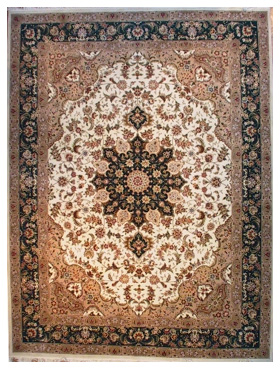Antique Persian Rug
This article contains:
Design Guide for Antique Persian Rug
Buyer's Guide for Antique Persian Rug
Selection Guide for Antique Persian Rug
General Care for Hand Made Antique Persian Rug
Product Reviews for Antique Persian Rug
Emergency Care for Antique Persian Rug
 Antique Persian rug is an essential part of Persian art and culture.
Carpet-weaving is undoubtedly one of the most distinguished manifestations
of Persian culture and art, and dates back to the Bronze Age. Antique Persian rug is an essential part of Persian art and culture.
Carpet-weaving is undoubtedly one of the most distinguished manifestations
of Persian culture and art, and dates back to the Bronze Age.
The earliest surviving corpus of antique Persian rugs come from the Safavid
dynasty (1501-1736) in the 16th century. However, painted depictions prove a
longer history of production. There is much variety among antique Persian
rugs of the 16th and 17th century. Common motifs include scrolling vine
networks, arabesques, palmettes, cloud bands, medallions, and overlapping
geometric compartments rather than animals and humans. This is because
Islam, the dominant religion in that part of the world, forbids their
depiction. Still, some show figures engaged either in the hunt or feasting
scenes. The majority of these rugs are wool, but several silk examples
produced in Kashan survive.
The major centers of antique Persian rug production in Persia were in Tabriz
(1500-1550), Kashan (1525-1650), Herat (1525-1650), and Kerman (1600-1650).
The majority of rugs from Tabriz have a central medallion and quartered
corner medallions superimposed over a field of scrolling vine ornament,
sometimes punctuated with mounted hunters, single animals, or animal combat
scenes. Perhaps the most well-known of the Tabriz works are the twin Ardabil
rugs most likely made for the shrine at Ardabil.
Kashan is known for its silk carpet production. Most famously, for the three
silk hunting carpet masterpieces depicting mounted hunters and animal prey.
The Kashan rugs are among the most valuable in existence. One carpet, for
example, is known to have been sold in Germany for $20,000 in 1969.
The Herat rugs, or ones of similar design created in Lahore and Agra, India,
are the most numerous in Western collections. They are characterized by a
red field with scrolling vine ornament and palmettes with dark green or blue
borders.
The seven classes of Kerman rug were defined by May Beattie. She identified
their unique structure and named it the "vase technique." Carpet types in
this group include garden carpets (ornamented with formal gardens and water
channels) and the ogival lattice carpets. A fine and well-known example of
the later was purchased by the Victoria and Albert Museum under the guidance
of William Morris. The influence of Persian carpets is readily apparent in
his carpet designs. For more information and selection on Persian carpets, please visit RugInc.com
An Antique Persian Rug is a piled or
flatwoven fabric hand-knotted in one of the traditional weaving areas of the
Middle or Far East. Genuine Oriental rugs and carpets come from Afghanistan,
China, India, Iran, Nepal, Pakistan, Tibet, Turkey, some of the southern
territories of the old Soviet Union (like Azerbaijan or Armenia), Balkan
countries like Romania and Albania, and some North African countries like
Morocco and Egypt. A Genuine Antique Persian Rug is not made in Belgium
or anywhere else in Western Europe or in the United States. No genuine
Oriental rugs are made of nylon or polypropylene.
Antique Persian Rug are
either knotted with pile or woven without pile. Antique Persian Rug made
by machine or any method other than hand knotting or hand weaving are not
considered authentic
Antique Persian Rug. If you wish to view various designs of Antique Persian Rug, please visit RugInc.com
Antique Persian Rug Design Guide
Kashan
Kashan rugs are categorized amongst the finest of the Persian rugs do to there very high quality wool, very fine weaving and beautiful colors and designs. The field of these Kashan
rugs is generally decorated by a central medallion which terminates
at the upper and lower ends in the flowering coronets. The rest of
the field is closely decorated with flowers and vine tendrils. In
the four quarters a richly decorated band outlines a motif which
recalls the designs and colors of the central medallion.
Mahal
Mahal rugs have large knots, which contributes to their softness. The decoration is either floral, but with large simple motifs, or of geometric style with a central diamond. The border is extremely simple and is of the traditional three-band type.
Chinese
The decoration of Chinese rugs is relatively simple and consists, for the most part, of various kinds of wavy line motifs along the edges and the Taoist and Buddhist emblem in the field.
|
 Antique Persian rug is an essential part of Persian art and culture.
Carpet-weaving is undoubtedly one of the most distinguished manifestations
of Persian culture and art, and dates back to the Bronze Age.
Antique Persian rug is an essential part of Persian art and culture.
Carpet-weaving is undoubtedly one of the most distinguished manifestations
of Persian culture and art, and dates back to the Bronze Age.